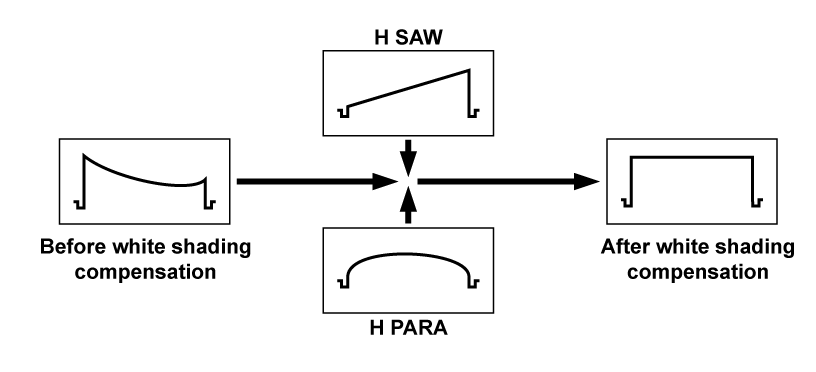Adjusting the white shading
This is a method of combining the sawtooth shaped waveform and parabola waveform to compensate to a flatter waveform based on the respective R, G and B waveforms of the video signal.
We recommend adjusting the R, G and B waveforms in the horizontal and vertical directions while monitoring them on the waveform monitor.
Before adjusting the white shading, make sure to cancel [DS.GAIN] and [D.ZOOM] set to the USER button.

Set the camera for adjustment.
Mount the lens on the camera.
Make sure to connect the lens cable.
Set the <SHUTTER> switch to <OFF>, and the <GAIN> switch to <L> (0 dB).
If the lens is equipped with an extender function, release the extender function.
Confirm that the [SCENE FILE] menu → [GAMMA MODE SEL] → [HD] is set.
Confirm that the [VIDEO OUT/LCD/VF] menu → [EI ASSIST] is set to as follows.
Change the setting if it is different.
[ZEBRA1 DETECT]:[70%]
[ZEBRA2 DETECT]:[85%]
[ZEBRA2]:[SPOT]
Set the <ZEBRA> switch in the viewfinder to <ON>.
Set the screen.
Shoot a white sheet of paper with no unevenness of color for the whole screen.
Set the lens aperture to manual, and adjust it so that the zebra pattern covers the whole viewfinder screen.
Make sure that the lens aperture control is between F4 to F11.
Adjust the position of the lighting because the zebra pattern will not cover the whole screen if there is any unevenness in the lighting.
Make adjustments to avoid several light sources of different color temperature (e.g. fluorescent lights and halogen lamp) from illuminating on the white paper.
Adjust the white balance/black balance.
Set the <WHITE BAL> switch to <A> or <B>, and use the <AUTO W/B BAL> switch to adjust white balance automatically (AWB).
Use the <AUTO W/B BAL> switch to adjust black balance automatically (ABB).
Use the <AUTO W/B BAL> switch to adjust white balance automatically (AWB) again.
Adjust white shading.
Set all of the following items in the [CAMERA] menu → [WHITE SHADING] to generate a waveform as flat as possible.
[R H SAW]
[R H PARA]
[R V SAW]
[R V PARA]
[G H SAW]
[G H PARA]
[G V SAW]
[G V PARA]
[B H SAW]
[B H PARA]
[B V SAW]
[B V PARA]
If the lens is equipped with an extender function, turn on the extender function and repeat steps 2 to 5.
Adjustment values are stored on the camera as a single lens file data using two patterns for when the lens is equipped and not equipped with the extender function.
Adjustment values are saved in memory, so there is no need to re-adjust white shading even after turning the camera off.